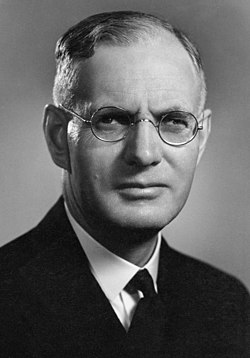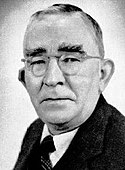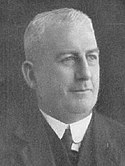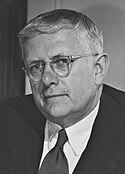Regierung Curtin II
Die Regierung Curtin II regierte Australien vom 21. September 1943 bis zum 6. Juli 1945. Es handelte sich um eine Regierung der Labor Party, der alle Minister angehörten.
Die Vorgängerregierung war eine Minderheitsregierung der Labor Party unter Premierminister John Curtin, die nur über 32 der 75 Sitze im Repräsentantenhaus verfügte.[1] Bei der Parlamentswahl am 21. August 1943 erhielt Labor 49,9 % der Stimmen und 49 der 75 Sitze im Repräsentantenhaus sowie 22 der 36 Sitze im Senat.[2] Curtin blieb Premierminister der neuen Laborregierung. Am 5. Juli 1945 starb Curtin, sein Nachfolger wurde für eine Woche Frank Forde, bisher Armeeminister und stellvertretender Premierminister.[3] Labor wählte Ben Chifley zum Vorsitzenden, der dann auch als Premierminister folgte.[4][5]
Ministerliste
| Minister | |||
|---|---|---|---|
| Amt | Minister | Amtszeit | Bild |
| Premierminister | John Curtin | 21. September 1943 – 5. Juli 1945 | |
| Verteidigungsminister | |||
| Armeeminister | Frank Forde | 21. September 1943 – 6. Juli 1945 | |
| Schatzminister | Ben Chifley | 21. September 1943 – 6. Juli 1945 | |
| Minister für Nachkriegs-Wiederaufbau | 21. September 1943 – 2. Februar 1945 | ||
| John Dedman | 2. Februar 1945 – 6. Juli 1945 | ||
| Generalstaatsanwalt | Herbert Vere Evatt | 21. September 1943 – 6. Juli 1945 | |
| Außenminister | |||
| Minister für Versorgung und Schifffahrt | Jack Beasley | 21. September 1943 – 2. Februar 1945 | |
| Bill Ashley | 2. Februar 1945 – 6. Juli 1945 | ||
| Marineminister | Norman Makin | 21. September 1943 – 6. Juli 1945 | |
| Munitionsminister | |||
| Minister für Handel und Zölle | Richard Keane | 21. September 1943 – 6. Juli 1945 | |
| Minister für Arbeit und Wehrpflicht | Jack Holloway | 21. September 1943 – 6. Juli 1945 | |
| Minister für die Luftwaffe | Arthur Drakeford | 21. September 1943 – 6. Juli 1945 | |
| Minister für die Luftfahrt | |||
| Minister für Wirtschaft und Landwirtschaft | William Scully | 21. September 1943 – 6. Juli 1945 | |
| Generalpostmeister | Bill Ashley | 21. September 1943 – 2. Februar 1945 | |
| Don Cameron | 2. Februar 1945 – 6. Juli 1945 | ||
| Vizepräsident des Executive Council | Bill Ashley | 21. September 1943 – 2. Februar 1945 | |
| Jack Beasley | 2. Februar 1945 – 6. Juli 1945 | ||
| Minister für Kriegswirtschaft | John Dedman | 21. September 1943 – 6. Juli 1945 | |
| Forschungsminister | 21. September 1943 – 19. Februar 1945 | ||
| Innenminister | Joe Collings | 21. September 1943 – 6. Juli 1945 | |
| Verkehrsminister | Eddie Ward | 21. September 1943 – 6. Juli 1945 | |
| Minister für die Außenterritorien | |||
| Gesundheitsminister | James Fraser | 21. September 1943 – 6. Juli 1945 | |
| Sozialminister | |||
| Minister für Repatriierung | Charles Frost | 21. September 1943 – 6. Juli 1945 | |
| Minister für Veteranenunterkünfte | |||
| Minister für Heimatschutz | Bert Lazzarini | 21. September 1943 – 6. Juli 1945 | |
| Bauminister | 2. Februar 1945 – 6. Juli 1945 | ||
| Minister für Flugzeugproduktion | Don Cameron | 21. September 1943 – 2. Februar 1945 | |
| Norman Makin | 2. Februar 1945 – 6. Juli 1945 | ||
| Informationsminister | Arthur Calwell | 21. September 1943 – 6. Juli 1945 | |
Weblinks
- Parliamentary Handbook for the 45th Parliament. (PDF; 13,4 MB) Part 6: Historical information on the Australian Parliament – Ministries and Cabinets. Parliament of Australia, S. 534 f., abgerufen am 5. Mai 2019 (englisch).
Einzelnachweise
- ↑ Geoffrey Serle: Curtin, John (1885–1945). In: Douglas Pike (Hrsg.): Australian Dictionary of Biography. Band 13. Melbourne University Press, Carlton (Victoria) 1994, ISBN 0-522-84512-6 (englisch).
- ↑ Stephen Barber: Federal election results 1901–2016—Reissue 2. (PDF; 2,9 MB) Parliament of Australia, S. 8, 33, 139, abgerufen am 4. Mai 2019 (englisch).
- ↑ Malcolm Saunders: Forde, Francis Michael (Frank) (1890–1983). In: Douglas Pike (Hrsg.): Australian Dictionary of Biography. Band 17. Melbourne University Press, Carlton (Victoria) 2007, ISBN 978-0-522-85382-7 (englisch).
- ↑ D. B. Waterson: Chifley, Joseph Benedict (Ben) (1885–1951). In: Douglas Pike (Hrsg.): Australian Dictionary of Biography. Band 13. Melbourne University Press, Carlton (Victoria) 1994, ISBN 0-522-84512-6 (englisch).
- ↑ Johannes H. Voigt: Geschichte Australiens. Alfred Kröner, Stuttgart 1988, ISBN 3-520-48801-9, S. 257 f.
Auf dieser Seite verwendete Medien
Edward James "Jack" Holloway, c. 1929
Norman Makin as Speaker of the House of Representatives
Hubert Lazzarini, member of the Australian House of Representatives for Werriwa
Commonwealth Coat of Arms of Australia granted by Royal Warrant signed by King George V on 19 September 1912.
IMPORTANT:This image is an artist's interpretation of the original (1912) official version of the Commonwealth Coat of Arms shown in Commons on the Australian coat of arms page. A variant of the original, with a transparent background, is shown on this page.
| “ | Quarterly of six, the first quarter Argent a Cross Gules charged with a Lion passant guardant between on each limb a Mullet of eight points Or; the second Azure five Mullets, one of eight, two of seven, one of six and one of five points of the first (representing the Constellation of the Southern Cross) ensigned with an Imperial Crown proper; the third of the first a Maltese Cross of the fourth, surmounted by a like Imperial Crown; the fourth of the third, on a Perch wreathed Vert and Gules an Australian Piping Shrike displayed also proper; the fifth also Or a Swan naiant to the sinister Sable; the last of the first, a Lion passant of the second, the whole within a Bordure Ermine; for the Crest on a Wreath Or and Azure A Seven-pointed Star Or, and for Supporters dexter a Kangaroo, sinister an Emu, both proper. | ” |
Frank Forde as Minister for the Army in 1941
































